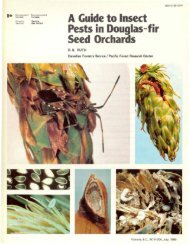A spatial, climate-determined risk rating for Scleroderris disease of ...
A spatial, climate-determined risk rating for Scleroderris disease of ...
A spatial, climate-determined risk rating for Scleroderris disease of ...
You also want an ePaper? Increase the reach of your titles
YUMPU automatically turns print PDFs into web optimized ePapers that Google loves.
Venier et al. 1403<br />
relationship with both variables was in the direction that was<br />
expected based on previous research. The <strong>risk</strong> <strong>rating</strong> <strong>for</strong><br />
<strong>Scleroderris</strong> <strong>disease</strong> was highest at colder temperatures and<br />
with more snow. There<strong>for</strong>e, the good fit <strong>of</strong> this model is<br />
consistent with our knowledge <strong>of</strong> the ecology <strong>of</strong> the fungus.<br />
The gridded estimates <strong>of</strong> <strong>climate</strong> allow us to map predictions<br />
<strong>of</strong> the probability <strong>of</strong> occurrence <strong>of</strong> the <strong>disease</strong> anywhere<br />
in Ontario. All sampling was conducted in red pine<br />
stands in a wide range <strong>of</strong> locations across the province;<br />
there<strong>for</strong>e, the <strong>climate</strong> domain sampled corresponds closely<br />
with the Ontario <strong>climate</strong> domain <strong>of</strong> red pine. We cannot<br />
legitimately extrapolate our model results outside <strong>of</strong> the <strong>climate</strong><br />
domain <strong>of</strong> our samples; there<strong>for</strong>e, we have not extended<br />
our <strong>spatial</strong> predictions into the far north <strong>of</strong> Ontario.<br />
A first, obvious test <strong>of</strong> a <strong>spatial</strong> prediction <strong>of</strong> the probability<br />
<strong>of</strong> occurrence is to compare the map <strong>of</strong> the prediction<br />
with the distribution <strong>of</strong> the <strong>disease</strong> from the raw data. Our<br />
<strong>spatial</strong> prediction matches well with the original observations.<br />
It is important to remember that the <strong>spatial</strong> distribution<br />
<strong>of</strong> the raw data was not directly included in the<br />
modelling process. Values <strong>of</strong> presence and absence were<br />
modelled against values <strong>of</strong> <strong>climate</strong>. This original model is<br />
not <strong>spatial</strong>ly explicit as would be the case when modelling<br />
with some geostatistical techniques such as kriging or<br />
splining. Our ability to make the <strong>spatial</strong> predictions is based<br />
on the availability <strong>of</strong> the gridded estimates <strong>of</strong> the independent<br />
<strong>climate</strong> variables over the area <strong>of</strong> concern, not on the<br />
<strong>spatial</strong>ly explicit nature <strong>of</strong> the original data.<br />
We have developed a consistent and highly predictive<br />
model <strong>for</strong> the relationship between the probability <strong>of</strong> occurrence<br />
<strong>of</strong> <strong>Scleroderris</strong> <strong>disease</strong> and <strong>climate</strong>. For a <strong>disease</strong>, this<br />
type <strong>of</strong> model and <strong>spatial</strong> prediction can be viewed as a “<strong>risk</strong><br />
<strong>rating</strong>” <strong>for</strong> the probability <strong>of</strong> occurrence. In the case <strong>of</strong> a<br />
hazard <strong>rating</strong>, the model and <strong>spatial</strong> extension tells us where<br />
we should be most vigilant about surveying <strong>for</strong> the <strong>disease</strong>.<br />
A lot <strong>of</strong> <strong>for</strong>est <strong>disease</strong>s, including white pine blister rust, are<br />
also known to be restricted in distribution by <strong>climate</strong>. In this<br />
case it is the infection period during the growing season that<br />
is restrictive. The fungus produces spores from July to September<br />
and requires a cool period <strong>for</strong> both spore production<br />
and successful infection; the infection process also requiring<br />
abundant moisture (van Arsdel et al. 1959; van Arsdel<br />
1961). Microsite and vegetation do have a significant effect<br />
on local <strong>climate</strong>; there<strong>for</strong>e, hazard to the <strong>disease</strong> can vary<br />
greatly over even a small area. However, <strong>for</strong> operational<br />
purposes, climatic data has been used to delineate hazard<br />
zones <strong>for</strong> white pine blister rust in the Lake States (Van<br />
Arsdel 1961), Quebec (Lavellee 1974), and more recently,<br />
Ontario (Gross 1985). Similarly, G. abietina requires cool<br />
wet periods <strong>of</strong> about 36 h <strong>for</strong> spore liberation and infection.<br />
This also imposes a climatic restriction in more southern areas.<br />
However, unlike blister rust, this process can occur at<br />
any point from late spring through early fall when conditions<br />
are appropriate (Skilling et al. 1986). In addition, <strong>disease</strong><br />
distribution <strong>of</strong> the EU race is believed to be largely<br />
through planting <strong>of</strong> infected nursery stock (Laflamme1993),<br />
but the <strong>disease</strong> has never been able to become established<br />
south <strong>of</strong> its present range even though cool wet springs and<br />
summers do occur periodically. Hence, we believe the greatest<br />
constraint to <strong>disease</strong> establishment to be cold period duration<br />
as suggested by Marosy et al. (1989). As with the<br />
Table 3. Summary <strong>of</strong> classification diagnostics <strong>for</strong> 10 replicates<br />
<strong>of</strong> sampling 50% <strong>of</strong> the original data to test classification<br />
accuracy.<br />
Classification<br />
diagnostics Mean Minimum Maximum SD<br />
Concordance 85.2 83.9 86.6 1.01<br />
Sensitivity 77.7 76.0 79.6 1.23<br />
Specificity 77.8 75.5 79.5 1.45<br />
False negatives 30.5 26.6 33.6 2.15<br />
False positives 15.7 14.3 17.4 1.19<br />
white pine blister rust, local <strong>climate</strong> conditions based on<br />
local topography, vegetation, and soils are likely to be important<br />
in determining the presence <strong>of</strong> the <strong>disease</strong>. However,<br />
the broader scaled <strong>climate</strong> provides the context <strong>for</strong> the local<br />
scale. Appropriate meso<strong>climate</strong> is a prerequisite <strong>for</strong> the<br />
<strong>disease</strong>.<br />
Many studies have examined the relationships between<br />
macro- or meso-<strong>climate</strong> and distribution <strong>of</strong> vegetation (e.g.,<br />
Woodward 1987; Huntley and Webb 1989; Lindenmayer et<br />
al. 1996) or distribution <strong>of</strong> animals (Nix 1986; Root 1988a,<br />
1988b; Repasky 1991). Woodward (1987) documents a long<br />
history <strong>of</strong> the recognition <strong>of</strong> these associations, although he<br />
acknowledges that the mechanisms are poorly understood.<br />
Other work on this scale has been used to link <strong>climate</strong> and<br />
biological distributions to improve bird atlas maps (Osborne<br />
and Tiger 1992) or to map wildlife distributions (Walker<br />
1990; Buckland and Elston 1993; Skidmore and Gauld 1996;<br />
Venier et al. in press). The <strong>spatial</strong> predictions arising from<br />
this type <strong>of</strong> statistical modelling have important management<br />
applications including providing in<strong>for</strong>mation on the<br />
probability <strong>of</strong> occurrence <strong>of</strong> a species where it has not been<br />
sampled. For places such as Ontario that have very large areas,<br />
much <strong>of</strong> which are inaccessible, the ability to reliably<br />
predict the probability <strong>of</strong> occurrence is essential <strong>for</strong> good<br />
land management.<br />
We thank Kathy Campbell, Terry Dumond, Kevin Lawrence,<br />
Janice McKee, Almos Mei, and Norm Szcyrek <strong>for</strong> logistic<br />
support.<br />
Bernier, L., Hamelin, R.C., and Ouellette, G.B. 1994. Comparisons<br />
<strong>of</strong> ribosomal DNA length and restriction site polymorphisms in<br />
Gremmeniella and Ascocalyx isolates. Appl. Environ. Microbiol.<br />
60: 1279–1286.<br />
Buckland, S.T., and Elston, D.A. 1993. Empirical models <strong>for</strong> the<br />
<strong>spatial</strong> distribution <strong>of</strong> wildlife. J. Appl. Ecol. 30: 478–495.<br />
Donaubauer, E. 1972. Distribution and hosts <strong>of</strong> <strong>Scleroderris</strong><br />
lagerbergii in Europe and North America. Eur. J. For. Pathol. 2:<br />
6–11.<br />
Dorworth, C.E. 1970. <strong>Scleroderris</strong> lagerbergii Gremmen and the<br />
pine replant problem in central Ontario. Dep. Fish. For. Can.<br />
For. Serv. Great Lakes For. Cent. Inf. Rep. No. O-X-139.<br />
Dorworth, C.E. 1976. Reducing damage to red pine by Gremmeniella<br />
abietina in the Great Lakes – St. Lawrence <strong>for</strong>est<br />
© 1998 NRC Canada


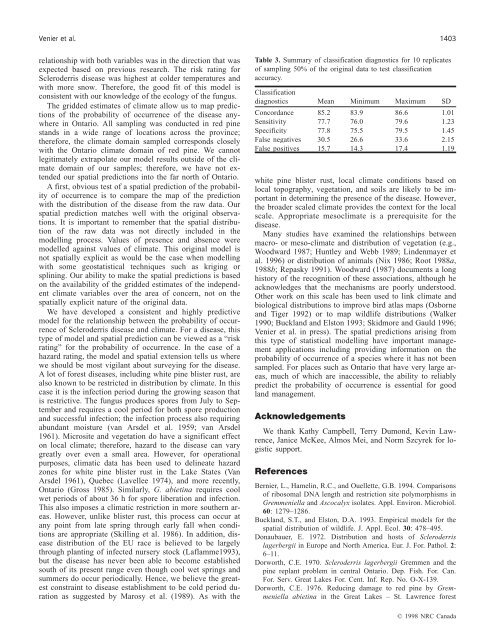
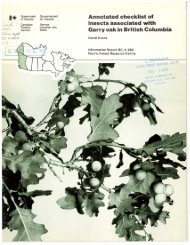
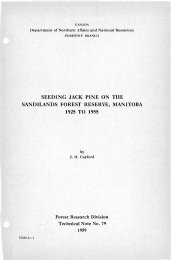
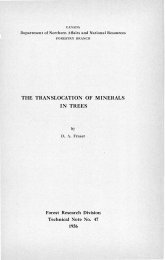
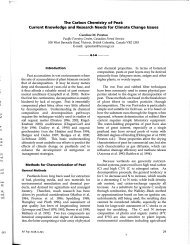



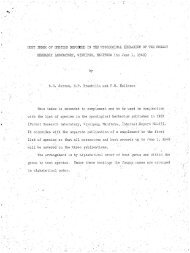
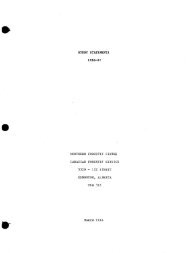
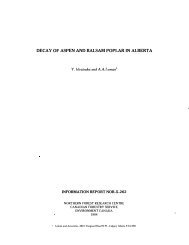
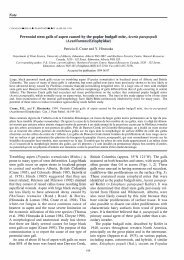
![Po],rell](https://img.yumpu.com/11946277/1/190x231/porell.jpg?quality=85)
